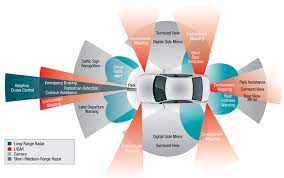Today’s automobiles are incredibly complex, both mechanically and digitally. Modern cars and trucks feature an array of computerized processes that help drivers with everything from steering and braking to detecting low tire pressure and faulty gas caps. Most digital processes are connected to sensors that can trigger alerts to let drivers know when something is wrong. Some sensors in vehicles are listed below:
Airbag Sensors
Airbags have been standard features in commuter automobiles since the 1990s, and today, airbags can include both driver- and passenger-side airbags as well as side-curtain airbags. When a vehicle is in a collision, airbags are often triggered by impact crush switches or sensors. A crush switch remains open until it is closed due to impact. A faulty crush switch may require you to have your vehicle serviced at your dealer. You can also visit https://www.select-controls.com to learn more about these components from Select Controls, a crush switch manufacturer.
Oxygen Sensors
Oxygen sensors in vehicles measure fuel efficiency and emissions. If you have a problem with components that handle emissions, oxygen sensors can trigger the “check engine” light. This light can also be triggered by something as simple as a loose gas cap, so it isn’t always a big deal. In most cases, a check engine light simply means that it is time to have your vehicle serviced at your closest dealership.
A problem with an oxygen sensor usually isn’t going to be anything that prevents your vehicle from operating normally, but it can lead to problems down the road. Faulty oxygen sensors that trigger a check engine light will usually cause the light to remain on constantly. Be aware, however, that a check engine light that is blinking often means something more serious is going on. If your check engine light starts blinking or is accompanied by a chime or other auditory alarm, you’re encouraged to find the nearest safe place to pull over and call for automotive assistance.
Crankshaft Position Sensor
A crankshaft sensors in vehicles helps to determine your engine’s speed by way of revolutions per minute (RPM). A crankshaft converts the linear motion of a piston into a rotational motion. If you have a faulty crankshaft position sensor, you may experience problems with acceleration and automatic gear shifting. In some cases, faulty crankshaft position sensors can also cause problems with your vehicle’s heating and air conditioning system.
While this sensor is fairly small and can be replaced by just about any mechanic, it would be wise to have your vehicle checked by a professional if it is exhibiting any common symptoms associated with crankshaft position sensor issues. Some of these symptoms mirror those of more serious problems, so it’s better to be safe than sorry.
Coolant Temperature Sensor
Your vehicle’s engine uses coolant to keep from overheating. Most coolants in today’s engines are made up of antifreeze or mixtures of antifreeze and water. Different vehicles take different types of antifreeze, so if you’re checking your vehicle’s coolant level or you’re adding coolant to your radiator, make sure you’re familiar with the type your vehicle takes.
Your vehicle’s coolant temperature sensor measures how hot your coolant and engine have become, and this information is vital for other processes like fuel injection. A cold engine will require a different amount of fuel compared to a hot engine, and the coolant temperature sensor helps to regulate these functions. In addition, the coolant temperature sensor plays a vital role in determining when fans and other accessories turn on or off to keep an engine running at its best.
Apart from that, if you are interested to know about 5 Safety Features You Didn’t Know Your Car Had then visit our Automobile category.

